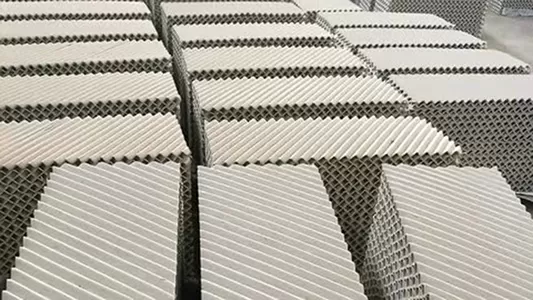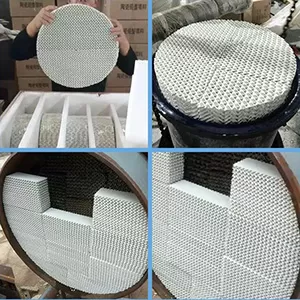Do Ceramic structured packings Need to Be Perforated?
Whether ceramic structured packings require perforations depends on their specific design, intended application, and performance goals. Perforations are not a universal requirement for ceramic structured packings, but they are incorporated in certain types to enhance functionality in specific industrial processes.

Ceramic structured packings, primarily known for their corrugated sheet designs, are engineered to optimize gas-liquid contact and mass transfer. In their basic form, many ceramic structured packings do not feature perforations. Their performance relies on the orderly arrangement of corrugated sheets, which create uniform channels for fluid flow. The corrugated surfaces themselves—often textured or roughened—increase specific surface area and promote liquid spreading, facilitating efficient mass transfer without the need for additional holes. This non-perforated design is sufficient for applications where moderate separation efficiency, high-temperature resistance, or corrosion resistance is the primary focus, such as in basic chemical processing or high-temperature gas absorption.
However, some ceramic structured packings are intentionally perforated to address specific process demands. Perforations—small holes drilled or formed in the corrugated sheets—serve several key purposes:
- Enhanced gas-liquid mixing: Perforations allow gas to pass through the sheet material, promoting cross-flow between adjacent channels and reducing the risk of gas-phase stagnation. This improves contact between the phases, boosting mass transfer efficiency, especially in processes requiring precise separation.
Reduced pressure drop: By providing additional pathways for gas flow, perforations can lower resistance to gas movement through the packing bed. This is beneficial in applications where minimizing energy consumption (e.g., in large-scale distillation towers) is critical.

- Prevention of liquid entrainment: In high-liquid-load scenarios, perforations help distribute excess liquid across the packing surface, reducing the likelihood of liquid being carried upward by the gas stream (entrainment) and improving operational stability.
Perforated ceramic structured packings are particularly useful in applications such as fine distillation, vacuum separation, or processes involving low-viscosity fluids, where maximizing mass transfer efficiency and minimizing pressure drop are priorities. However, the decision to use perforated designs must balance these benefits against potential drawbacks: perforations can slightly reduce the mechanical strength of ceramic sheets, making them more susceptible to damage in high-pressure or abrasive environments. Additionally, in processes with high levels of particulate matter, perforations may be prone to clogging, requiring more frequent maintenance.
In summary, perforations are not essential for all ceramic structured packings. Non-perforated designs suffice for many applications, leveraging their corrugated structure and material properties to deliver reliable performance. Perforated variants, on the other hand, are specialized solutions tailored to enhance efficiency and flow dynamics in specific separation processes, with their use depending on the unique demands of the application.

